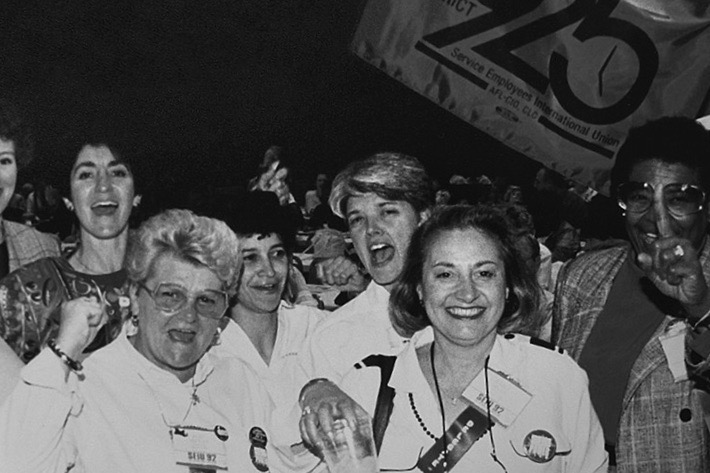Let's Talk Human Rights

Lessons Learned From 9to5: The Story of A Movement, on How to Generate a Human Rights-Based Social Movement
By Heiela Salhieh and Salha El-Shwehdi
In celebration of International Women’s Day, the Human Rights Center co-hosted a screening of the new documentary 9to5 by Oscar-winning filmmakers Julia Reichert and Steve Bognar. In the early 1970s, a group of female Boston secretaries began organizing labor unions to fight for better wages, advancement opportunities, and an end to sexual harassment in the workplace. Their fight for equality galvanized a nationwide movement called 9to5. The documentary explores this women’s movement's history and parallels the continued struggle for women's rights today.
The 9to5 documentary demonstrated how to generate a human rights-based social movement. As captured by the documentary, the 9to5 movement utilized four key ingredients that made it successful. They are: (1) organizing the people who are impacted; (2) defining and simplifying the issues; (3) creating a safe and supportive meeting place; and (4) taking actions that make campaigns winnable and publicly acknowledged.
1. Organizing the people who are impacted
The women of the 9to5 movement carried out several efforts to raise awareness and garner support. As a result, thousands of women joined together to challenge authority and fight for equal rights to men. Efforts such as strikes proved to be effective in raising awareness of the unfair treatment of women in the workplace.
Another fruitful effort was the creation of the 9to5 group. Word quickly spread that hundreds of women were willing to contest the discrimination they faced in the workplace, leading to the creation of 9to5 groups across the country. This demonstrates that engaging individuals who are impacted by similar issues can spark a human rights-based social movement.
There is strength in numbers and those in power are more likely to respond to issues brought forth by a larger population. Further, change is often opposed by those enforcing and benefitting from the status quo, thus making broad engagement crucial to a social movement.
2. Defining and simplifying the issues
To define and simplify issues concerning the unequal treatment of women in the workplace, the 9to5 group circulated surveys to identify and evaluate these disparities. The surveys described common inequities and incidences of sexism that women faced in the workplace and asked women to discuss the individual hardships and experiences they endured in the workplace. The results indicated that sexual harassment, unequal wages, lack of job descriptions, and maternity leave issues were most commonly faced.
These results allowed the 9to5 group to define and simplify the key issues of their movement. For example, the 9to5 group created the term “sexual harassment”. Prior to the 9to5 movement, there was no terminology to adequately describe or define the unwanted sexual advances and obscene remarks made by men in the workplace. The 9to5 group labeled this frequent occurrence, subsequently initiating awareness and identification of sexual harassment in the workplace on a national level.
Furthermore, defining and simplifying the grievances that women endured led to the creation of the Bill of Rights for Women Office Workers. This document focused on clear demands, such as clearly defined and written job descriptions, compensation for overtime work, regular salary reviews, maternity benefits, on-the-job training programs, and benefits equal to those of men.
When generating a human rights-based movement, it is important to remain steadfast in the goals of the movement. The organizers of 9to5 appealed to several unions which ultimately declined their requests, but they never stopped trying. Rather, they continued their fight for independence and autonomy and eventually succeeded in negotiating key changes, such as independent offices and equal pay between men and women.
3. Creating a safe and supportive meeting place
The creation of a meeting place was crucial to the 9to5 movement. It brought similarly situated women face-to-face to discuss the hardships they endured. The meeting place provided a safe space for hundreds of women to assemble for conversations and build relationships among them – ultimately growing their network of supporters and followers. These spaces also contributed to better dissemination of information concerning the 9to5 movement and its current issues. Altogether, the creation of safe and supportive meeting places improved the organization of protests and events that spread awareness of discrimination in the workplace to the public.
4. Taking actions that are winnable and publicly acknowledged
The documentary offered powerful insight into the type of actions women had to engage in to be heard. The District 925 Labor Union had several issues on their docket, however, the women of District 925 decided to pursue the reinstalment of tampon dispensers within the workplace by engaging in collective bargaining. Although this was not the most important issue on the docket at the time, their efforts proved successful. The women were unapologetic in their identity, which proved they were in control of their own agenda and were willing to comprehensively fight for the needs of their members. New ideas and movements often face opposition and can be minimized by those enforcing and benefiting from the status quo. However, remaining unapologetic, pushing boundaries, and addressing all inequities is what leads us to substantive change. This collective bargaining campaign, the Women’s Strike, and the Bill of Rights for Women Office Workers are all examples of actionable wins that can claim public acknowledgment.
Overall, generating a human rights-based social movement needs commitment, consistency and hard work. For us, the 9to5 movement as portrayed in the documentary exemplified how to successfully generate a human-rights-based social movement.
Heiela Salhieh is a second-year law student from New Carlisle, Ohio. She is passionate about advocating for social justice and hopes to pursue a career in immigration law one day.
Salha El-Shwehdi is a second-year law student from Dayton, Ohio. She is a student member of UDSL Human Rights Awareness and Advocacy Group, the Diversity, Equity, and Inclusivity Committee, and is a staff-writer on Law Review.
